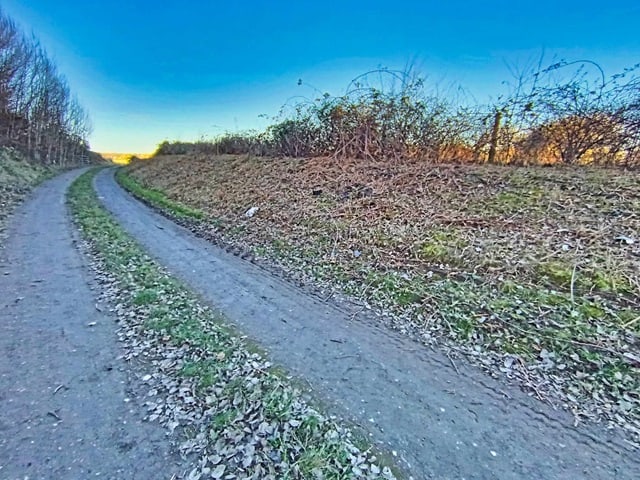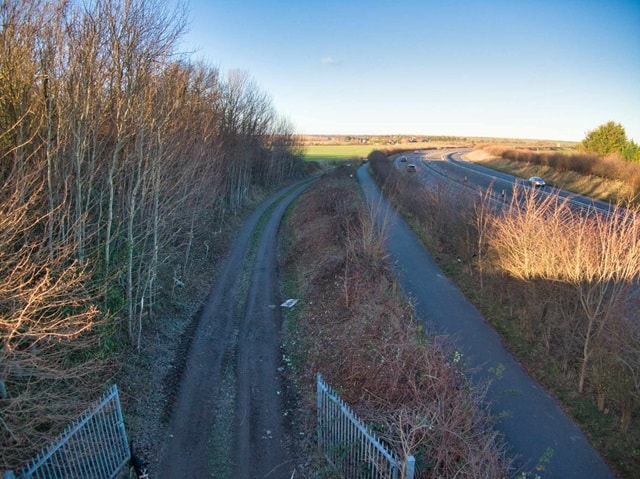
Questions have been raised over who carried out the clearance of vegetation and brambles at a track by Minster marshes which was being used a dormouse survey site.
Last week an entire verge length of brambles and foliage was shredded at the track between the A256 Richborough Way and Jutes Lane.
The path is around 400m from the area where National Grid proposes to build a converter station and infrastructure and is currently part of the company’s construction traffic access.

The clearance shredded a number of Dormouse tubes that had been situated along the verge as part of the survey. Hazel dormice are legally protected under Schedule 5 of the Wildlife and Countryside Act 1981 and have significant further protection as a European Protected Species under the Conservation of Habitats and Species Regulations 2010.
The clearance was discovered by Thanet nature enthusiast Nik Mitchell who picked up shredded up dormouse tubes within the site.
He said: “Someone has come down and cut the lot of it, right where they were surveying dormice.
“It’s absolutely insane to see this large chunk of important habitat, even though there was dormice in there, just to see it shredded like that.”
An area being used to survey for Dormice was destroyed this week. 😡 pic.twitter.com/Ak7lYUfDqH
— Get Wild 🐦 🦋 🐝 🍃 (@mitchellsnik) January 13, 2024
He added: “Minster marshes is an incredibly important area for many reasons. It is currently under threat from giant development by National Grid.
“This bit of destruction is bad for two main reasons- firstly, surveying the area for wildlife is incredibly important, because if ecologists can’t prove what’s there it is less likely to get protected. So to see a chunk of dormouse survey area being destroyed is bad news not just for any potential dormice or other wildlife that was in/using that verge but for the integrity of the survey.
“And secondly, although many people have been approached to find out who did this, nobody has admitted it. People often think the threat from giant developments is just the buildings and infrastructure itself but actually it’s the survey and construction stage that also causes much damage.”

National Grid and Kent County Council both say they have not carried out works at the site. Thanet council also says it is unaware of the works.
A spokesperson for National Grid said there was confirmation from Highways at Kent County Council that they carried out vegetation works last week on the land in question.
However, a Kent County Council spokesperson reiterated thee first statement that the authority was not responsible. A spokesperson said: “I can confirm KCC is not aware of any works.
“One of our officers walked the site this morning and confirmed there has been no vegetation clearance within the highway-maintained boundary next to the cycle track.”
Thanet council says: “The land isn’t under the control of the council, so this clearance wasn’t carried out by officers.”
According to the National Grid survey website, the dormouse survey work at the site took place in October and November.

Kent Wildlife Trust says the clearance means a loss of habitat for any dormice that had been on the site.
A spokesperson said: “Kent Wildlife Trust is aware of an incident close to Jutes Lane, Minster, whereby a hedgerow under survey for dormice, was cut to ground level.
“There appears to have been a breakdown in communication between National Grid, who were conducting the study as part of the ecology surveys for their proposed Sea Link scheme, and (the person who carried out the works) who was seemingly unaware of the possibility that dormice may be living in the area.
“If there had been dormice present they would have been hibernating at ground level, so by cutting from the ground, that habitat has been lost.
“We are concerned that these surveys should have formed part of the Preliminary Environmental Impact Report (PEIR) submitted by National Grid last year for which public consultation closed in December. We question how the public can raise environmental concerns when National Grid still has not completed many of the surveys that are needed.
“I would like to appeal to National Grid to take the time to complete the many ecological surveys that remain outstanding and re-submit their PIER report so that the public can respond accordingly.
“We support the use of renewable energy, but not at the cost to wildlife and not when there are five alternative, less environmentally impactive routes available for this project, now is the time for the National Grid to Rethink Sea Link.”

Sea Link is a National Grid project which will include a 60,000 square metre (6 hectares) onshore converter station at Minster marshes in the Stour Valley.
The Sea Link project involves creating a subsea electricity cable between Suffolk and Kent which National Grid says will help deliver the UK’s energy security strategy and net zero targets.
The proposals outline a preferred route of 10km of onshore and 140km of undersea cables, together with potential landfall and converter station locations at Friston substation in Suffolk and at Richborough.
National Grid’s preferred route runs from a landfall in Pegwell Bay to a proposed converter station site and high voltage pylons over the land to the south of Minster.
Th converter station will be 26 metres high and have external equipment such as lightning protection and walkways. A new substation would be built adjacent to it.
Kent Wildlife Trust has launched a campaign calling on the National Grid to “Rethink Sea Link” and avoid the proposed route which causes the most environmental impact.
Conservationists are concerned the current route for a proposed electricity cable will cause disturbance to wildlife at the internationally important National Nature Reserve Pegwell Bay and surrounding nature sites.
Find details of the Sea Link proposal at: https://www.nationalgrid.com/electricity-transmission/network-and-infrastructure/infrastructure-projects/sealink
Timeline
The Sea Link project needs to obtain a development consent order (DCO) via an application to the Planning Inspectorate.
The Secretary of State is expected to make a decision in 2025 with construction then taking place, if granted, between 2026 and 2030.
Campaign
A campaign page Save Minster Marshes has been set up by George Cooper on facebook for those who want to fight the proposals.

